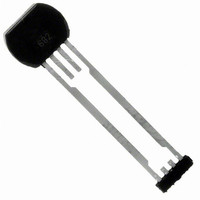ATS682LSHTN-T Allegro Microsystems Inc, ATS682LSHTN-T Datasheet - Page 14

ATS682LSHTN-T
Manufacturer Part Number
ATS682LSHTN-T
Description
IC HALL EFFECT SENSOR 4SIP
Manufacturer
Allegro Microsystems Inc
Type
Linear Field Sensorr
Datasheet
1.ATS682LSHTN-T.pdf
(16 pages)
Specifications of ATS682LSHTN-T
Package / Case
4-SIP
Sensing Range
120mV Trip, 120mV Release
Voltage - Supply
4 V ~ 24 V
Current - Supply
16.8mA
Output Type
Analog
Features
Gear Tooth Type
Operating Temperature
-40°C ~ 150°C
Bandwidth
40kHz
Supply Voltage Max
24V
Hall Effect Type
Gear Tooth
Operating Temperature Range
-40°C To +150°C
Supply Voltage Min
4V
Lead Free Status / RoHS Status
Lead free / RoHS Compliant
Current - Output (max)
-
Lead Free Status / RoHS Status
Lead free / RoHS Compliant, Lead free / RoHS Compliant
Other names
620-1327-2
Available stocks
Company
Part Number
Manufacturer
Quantity
Price
Company:
Part Number:
ATS682LSHTN-T
Manufacturer:
ST
Quantity:
101
ATS682LSH
The device must be operated below the maximum junction tem-
perature of the device, T
peak conditions, reliable operation may require derating supplied
power or improving the heat dissipation properties of the appli-
cation. This section presents a procedure for correlating factors
affecting operating T
Allegro MicroSystems Web site.)
The Package Thermal Resistance, R
marizing the ability of the application and the device to dissipate
heat from the junction (die), through all paths to the ambient air.
Its primary component is the Effective Thermal Conductivity,
K, of the printed circuit board, including adjacent devices and
traces. Radiation from the die through the device case, R
a relatively small component of R
T
overmolding.
The effect of varying power levels (Power Dissipation, P
be estimated. The following formulas represent the fundamental
relationships used to estimate T
For example, given common conditions such as: T
V
A worst-case estimate, P
able power level (V
T
A
J
CC
(max), at a selected R
, and air motion are significant external factors, damped by
T = P
= 12 V, I
T = P
CC
P
T
D
J
= 7 mA, and R
= V
D
= T
P
T
×
CC
D
J
J
A
CC
. (Thermal data is also available on the
= T
(max), I
R
= V
+ T = 25°C + 10.6°C = 35.6°C
JA
JA
J
×
D
(max). Under certain combinations of
A
D
(max), represents the maximum allow-
IN
I
+ ΔT
= 84 mW
and T
×
CC
×
CC
R
= 12 V
JA
J
I
JA
, at P
IN
(max)), without exceeding
A
JA
.
= 126 °C/W, then:
JA
. Ambient air temperature,
D
×
×
.
, is a figure of merit sum-
126 °C/W = 10.6°C
7 mA = 84 mW
A
= 25°C,
Miniature, Two-Wire, True Zero Speed
Power Derating
JC
D
Differential Peak-Detecting Sensor IC
), can
, is
(1)
(2)
(3)
Example: Reliability for V
Observe the worst-case ratings for the device, specifically:
R
I
Calculate the maximum allowable power level, P
invert equation 3:
This provides the allowable increase to T
power dissipation. Then, invert equation 2:
Finally, invert equation 1 with respect to voltage:
The result indicates that, at T
dissipate adequate amounts of heat at voltages ≤V
Compare V
able operation between V
R
V
CC
JA
JA
CC
V
T(max) = T
P
= 16.8 mA.
CC(est)
(max) is reliable under these conditions.
. If V
= 126°C/W, T
D
(max) = T(max) ÷ R
= P
CC(est)
CC(est)
D
(max) ÷ I
J
(max) – T
≥ V
to V
J
(max) = 165°C, V
CC(max)
CC
CC
(max). If V
CC(est)
CC
A
= 119 mW ÷ 16.8 mA = 7.1V
115 Northeast Cutoff
1.508.853.5000; www.allegromicro.com
Allegro MicroSystems, Inc.
Worcester, Massachusetts 01615-0036 U.S.A.
, then operation between V
= 165 °C – 150 °C = 15 °C
A
at T
JA
, the application and device can
and V
A
= 15°C ÷ 126 °C/W = 119 mW
= 150°C.
CC(est)
CC
CC
(max) = 24 V, and
(max) requires enhanced
J
resulting from internal
≤ V
CC
(max), then reli-
D
CC(est)
(max). First,
CC(est)
.
and
14












